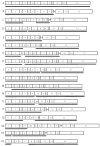Alternatively Spliced Isoforms of the P2X7 Receptor: Structure, Function and Disease Associations
- PMID: 35897750
- PMCID: PMC9329894
- DOI: 10.3390/ijms23158174
Alternatively Spliced Isoforms of the P2X7 Receptor: Structure, Function and Disease Associations
Abstract
The P2X7 receptor (P2X7R) is an ATP-gated membrane ion channel that is expressed by multiple cell types. Following activation by extracellular ATP, the P2X7R mediates a broad range of cellular responses including cytokine and chemokine release, cell survival and differentiation, the activation of transcription factors, and apoptosis. The P2X7R is made up of three P2X7 subunits that contain specific domains essential for the receptor's varied functions. Alternative splicing produces P2X7 isoforms that exclude one or more of these domains and assemble in combinations that alter P2X7R function. The modification of the structure and function of the P2X7R may adversely affect cellular responses to carcinogens and pathogens, and alternatively spliced (AS) P2X7 isoforms have been associated with several cancers. This review summarizes recent advances in understanding the structure and function of AS P2X7 isoforms and their associations with cancer and potential role in modulating the inflammatory response.
Keywords: ATP; P2X7R; alternative splicing; cancer; inflammation.
Conflict of interest statement
The authors declare that they have no conflict of interest.
Figures





Similar articles
-
Structure, function and techniques of investigation of the P2X7 receptor (P2X7R) in mammalian cells.Methods Enzymol. 2019;629:115-150. doi: 10.1016/bs.mie.2019.07.043. Epub 2019 Sep 3. Methods Enzymol. 2019. PMID: 31727237
-
Structural and Functional Basis for Understanding the Biological Significance of P2X7 Receptor.Int J Mol Sci. 2020 Nov 10;21(22):8454. doi: 10.3390/ijms21228454. Int J Mol Sci. 2020. PMID: 33182829 Free PMC article. Review.
-
Recent Advances in the Development of Antidepressants Targeting the Purinergic P2X7 Receptor.Curr Med Chem. 2023;30(2):164-177. doi: 10.2174/0929867329666220629141418. Curr Med Chem. 2023. PMID: 35770396 Review.
-
The purinergic receptor P2X7 role in control of Dengue virus-2 infection and cytokine/chemokine production in infected human monocytes.Immunobiology. 2016 Jul;221(7):794-802. doi: 10.1016/j.imbio.2016.02.003. Epub 2016 Feb 27. Immunobiology. 2016. PMID: 26969484
-
Variations in Cellular Responses of Mouse T Cells to Adenosine-5'-Triphosphate Stimulation Do Not Depend on P2X7 Receptor Expression Levels but on Their Activation and Differentiation Stage.Front Immunol. 2018 Feb 27;9:360. doi: 10.3389/fimmu.2018.00360. eCollection 2018. Front Immunol. 2018. PMID: 29535730 Free PMC article.
Cited by
-
Purinergic Signalling in Physiology and Pathophysiology.Int J Mol Sci. 2023 May 24;24(11):9196. doi: 10.3390/ijms24119196. Int J Mol Sci. 2023. PMID: 37298149 Free PMC article.
-
Deep learning structural insights into heterotrimeric alternatively spliced P2X7 receptors.Purinergic Signal. 2024 Aug;20(4):431-447. doi: 10.1007/s11302-023-09978-3. Epub 2023 Nov 30. Purinergic Signal. 2024. PMID: 38032425 Free PMC article.
-
The P2X7 Receptor in Oncogenesis and Metastatic Dissemination: New Insights on Vesicular Release and Adenosinergic Crosstalk.Int J Mol Sci. 2023 Sep 9;24(18):13906. doi: 10.3390/ijms241813906. Int J Mol Sci. 2023. PMID: 37762206 Free PMC article. Review.
-
The P2X7 receptor in leukemia: pathological mechanisms and therapeutic potential.Purinergic Signal. 2025 Aug 22. doi: 10.1007/s11302-025-10108-4. Online ahead of print. Purinergic Signal. 2025. PMID: 40844672 Review.
-
Role of Pannexin 1, P2X7, and CFTR in ATP Release and Autocrine Signaling by Principal Cells of the Epididymis.Function (Oxf). 2025 Mar 24;6(2):zqaf016. doi: 10.1093/function/zqaf016. Function (Oxf). 2025. PMID: 40128095 Free PMC article.
References
Publication types
MeSH terms
Substances
Grants and funding
LinkOut - more resources
Full Text Sources
Medical
Research Materials

